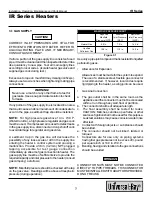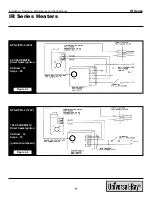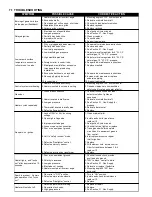
7.1 TROUBLESHOOTING
SYMPTOM
POSSIBLE CAUSE
CORRECTIVE ACTION
1. Heater mounted at incorrect angle.
1. Mounting angle 20º-35º from horizontal.
2. Excessive drafts.
2. Relocate or shield from draft.
3. Gas leaking at orifice, spud, pilot tube.
3. Check with leak detector solution.
4. Separation of ceramic grids.
4. Replace rayhead.
5. Ceramic grids cracked.
5. Replace rayhead.
1. Electrode out of specification.
1. See Ignition System insert.
2. Low gas pressure.
2. See Section 3.1, Gas Supply.
3. Partially blocked orifice.
3. Clean or replace.
4. Improper orifice size.
4. Consult dealer.
5. Incorrect gas.
5. See unit nameplace.
1. Dirty or plugged rayhead ceramics.
1. See perodic maintenance instructions.
2. Partially blocked orifice.
2. Remove and clean.
3. Low inlet gas pressure.
3. See Section 3.1, Gas Supply.
4. Low manifold gas pressure.
4. Adjust main valve regulator for 6" W. C.P.
natural gas, 10" W. C.P. propane.
5. High manifold pressure.
5. Adjust main valve regulator for 6" W. C.P.
natural gas, 10" W. C.P. propane.
6. Foreign matter in venturi tube.
6. See periodic maintenance instructions.
7. Misaligned manifold from excessive
7. Replace manifold.
torque applied on pipe during
installation.
8. Excessive dark spots on rayhead.
8. See periodic maintenance instructions.
9. Gas supply piping too small.
9. Increase inlet pressure or replace
undersize piping.
10. Incorrect gas.
10. See unit nameplate.
1. Heater not mounted correctly.
1. Mounting angle 20º-35º from horizontal.
2. Heater mounted too close to ceiling.
2. Observe clearance to combustibles
safety chart located on heater reflector.
1. Loose pipe connection.
1. Check all connections with leak-
detector solution, tighten as
necessary.
1. Heater located in drafty area.
1. Relocate or shield from draft.
2. Low gas pressure.
2. See Section 3.1, Gas Supply for
propane.
3. Thermostat located in drafty area.
3. Relocate thermostat.
4. Defective flame detector.
4. Replace.
1. Lack of 120V or 24V incoming
1. Clean or adjust pilot.
voltage.
2. Open high voltage wire.
2. Isolate and ohm for resistance,
replace if 0.
3. Improper electrode gap.
3. See Ignition System insert.
4. Loose or open wire connection.
4. Check all wires, tighten or replace.
5. Poor or no equipment ground.
5. Trace ground wire for complete
circuit back to equipment ground
from control.
6. Unit in "safety lockout" mode.
6. Interrupt power source, repeat
trial for ignition.
7. Defective "Gaslighter" control.
7. Replace.
8. Defective mercury sensor.
8. With element cold, isolate control.
Ohm for resistance between 3 & 4.
replace if 0.
9. Defective pilot ignition transformer.
9. Replace.
1. Poor or no equipment ground.
1. Check all connections, provide
positive earth ground.
2. Polarity is reversed.
2. 120V to black, neutral to white.
3. Low gas pressure.
3. See Section 3.1, Gas Supply.
4. Electrode not sensing.
4. Relocate or replace if defective.
5. Heater mounted at incorrect angle.
5. Mounting angle 20º-35º from
horizontal.
1. Gas valve in "OFF" position.
1. Turn to "ON" position.
2. Defective main valve solenoid.
2. Isolate and check for resistance.
replace if 0.
3. Defective "Gaslighter" control.
3. Replace.
1. Defective thermostat or wiring.
1. Replace or repair.
2. Gas valve stuck open.
2. Replace.
3. High gas pressure.
3. See Section 3.1, Gas Supply.
Burning of gas-air mixture
inside plenum (flashback).
Delayed ignition.
Low ceramic surface
temperature, excessive
rollout or soot on rods.
Control system overheating.
Spark is present. No main
gas operation. Unit "locks
out".
Heater will not shut off.
Gas odor.
Heater cycles repeatedly.
No spark; no ignition.
Heater lights, and "locks
out" after approximately 10
seconds.






























